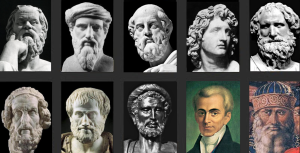
Architects, Mathematicians, Scholars, Engineers, Physicist, Inventor (Isidore), Writer (Anthemius) (6th century), (c447 – 558)
Isidore was born in Miletus sometime during the 6th century. He was a scholar and architect and was the founder of an engineering school in the Byzantine Empire. He taught physics and stereometric geometry, first in Alexandria and then in Constantinople. He compiled works of Archimedes and Euclid, wrote important treatises of his own and was rector of the Academy of Athens. In addition, he is credited with inventing an instrument for the measurement of hyperbolae. Anthemius was another brilliant architect and writer who taught geometry in the University of Constantinople. His profound knowledge on the conic sections enabled him to construct complex architectural marvels. Like Isidore, he had special interest on physics as proven by his researches on mirrors. Anthemius was also an engineer who created anti flooding systems for the capital.
Both had been students of the famous mathematician Proclus, who burned down the Goth’s fleet in 514 in Constantinople using a system similar to that of Archimedes from antiquity. Both were undoubtedly genius mathematicians and possessed extraordinary engineering skills, for which they were tasked in 531 with the construction of Hagia Sophia in the capital of the Byzantine Empire, the holiest Greek orthodox church dedicated to God’s wisdom.
Even before undertaking this difficult task, Isidore and Anthemius were already renowned throughout the world for their work individually. According to Paulus Silentiarius, Isidore was “the wisest of them all” while Anthemius was said to have reached the top of mathematical science. Words of their accomplishments had spread to every country until they reached Emperor Justinian’s ears in 531. He entrusted them with the creation of the Hagia Sophia and appointed them in charge of one hundred architects, each of whom was assigned 100 workers divided into two teams, each consisting of 5000 workers. In just 5 years, 10 months and 4 days, the temple had been completed.
Isidore and Anthemius represented the Greek architectural science. The shape of Hagia Sophia comes directly from the ancient Greek Stoa Basileios or Royal Stoa, where the people used to have gatherings. The sculptures, the mosaics and the art all reflect the glorious past of the Greek spirit. The golden altar, as well as all the holy relics was made of gold while the dome with a diameter of 31 meters seems as if it is floating in mid-air. Niketas Akominatos called it “earthly sky”.
Hagia Sophia is not simply a Christian temple; it is one of the wonders of architecture. It is a monument of insuperable beauty which stands today with its indomitable magnificence as a feat of modern architecture.
Bibliography
- Pleuris, Konstantinos. Hagia Sophia, Athens: Hilektron, 2012. Print.

[…] Head Constractor Isibore – Isidore of Miletushttps://wiki.wizard101central.com/wiki/NPC:Head_Constractor_Isiborehttps://greatestgreeks.wordpress.com/2016/06/29/isidore-of-miletus-anthemius-of-tralles/https://en.wikipedia.org/wiki/Isidore_of_Miletus […]
LikeLike
[…] Architect Antheemius – Anthemius of Tralleshttps://wiki.wizard101central.com/wiki/NPC:Architect_Antheemiushttps://greatestgreeks.wordpress.com/2016/06/29/isidore-of-miletus-anthemius-of-tralles/https://en.wikipedia.org/wiki/Anthemius_of_Tralles […]
LikeLike
[…] Architect Antheemius – Anthemius of Tralleshttps://wiki.wizard101central.com/wiki/NPC:Architect_Antheemiushttps://greatestgreeks.wordpress.com/2016/06/29/isidore-of-miletus-anthemius-of-tralles/https://en.wikipedia.org/wiki/Anthemius_of_Tralles […]
LikeLike
Is the icon of Anthemius and Isidore by Rene Magritte?
LikeLike
Hello. The portrait is by poet and artist Nikos Engonopoulos.
LikeLike
[…] the name Proclus the Successor. Proclus served as headmaster of the Academy of Athens for 50 years. Isidore of Miletus and Anthemius of Tralles, the architects of Hagia Sophia were both his […]
LikeLike